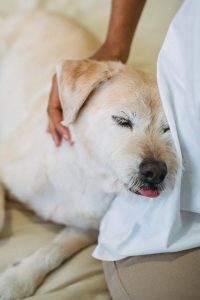When vets talk about euthanasia, it means bringing your dog’s life to a peaceful end with an overdose of anaesthetic. Over 90% of all deaths will be assisted in this way. Fewer than 9% of dogs will have unassisted deaths.
Humans live a lot longer than dogs. Saying goodbye is something all of us who share our lives with a dog will have to face at some time. Other expressions used for euthanasia, such as ‘putting to sleep’ or ‘putting down’ are often used. But they can have different meanings to different people in different situations. We have to be absolutely clear about what happens in euthanasia. This article will describe the procedure, decisions and possible challenges associated with euthanasia. And point to sources of support for anyone affected by the loss of a pet.

What it’s for
Euthanasia – what it’s for and when it’s carried out
Euthanasia is the means by which vets and owners can prevent suffering in dogs.
Unlike humans in the UK, for whom assisted dying is not currently an option, animals can be released from terminal illness and poor quality of life. However, the decision to euthanize a pet is a painful one that’s never taken lightly. It’s best taken by an owner and vet working together.
Euthanasia is most likely to happen in the final stages of a long and worsening illness, usually at an older age. But it may also be the sudden devastating outcome of an accident or severe infection. Whatever the circumstances, we can act in our dogs’ best interests by keeping their welfare, wellbeing and quality of life at the forefront of any discussion and decisions. Including those surrounding euthanasia.
Euthanasia of a healthy dog can happen under certain circumstances:
- After biting or attacking humans
- When the dog is recognised as an illegal breed under the Dangerous Dogs Act of 1991 and cannot be rehomed.
- Lack of long-term shelter accommodation for abandoned and stray dogs.
- Owner’s request following a change in personal circumstances.
Vets are not legally or professionally obliged to euthanize healthy pets at the owner’s request.
Considerations beforehand
If possible, arrange a consultation to talk through euthanasia before arranging the procedure itself. This is an opportunity to:
- Ask any questions and talk through concerns
- Decide whether you want to stay with your dog
- Find out about the cremation options
- Sign the required paperwork – the consent form (see below)
- To find out about costs and, if preferred, to settle payment in advance
Choosing a location
Euthanasia usually happens at a vet practice. Talk to your vet if you don’t feel this is the best option for your dog and you would prefer a home visit.
Vet practice
Advantages
- Best facilities and help to ensure euthanasia goes smoothly
- Set time can be arranged early or late in the day when it’s a quieter environment
- Vet can arrange cremation directly
Disadvantages
- Some dogs are anxious in the strange-smelling vet practice
Home
Advantages
- More relaxed home environment
- No other people around
- Don’t have to move a heavy or painful dog into the car to go to the vet
- Personal care of your dog’s remains if wished
Disadvantages
- Cost
- Uncertain timing of visit
- Less straightforward if additional sedation or a different approach is required
- Keeping your dog’s body at home until the crematorium is open or can collect them
- Transporting your dog’s remains from home to vet practice or crematorium
Consent forms
Owners have to sign a consent form for euthanasia. This is a legal requirement. It must be signed by the owner or someone with authority to sign on the owner’s behalf. In either case, this must be an adult over 18, who is fully able to understand the procedure and the consent form
Staying with your dog or not
We are all different so this is an individual decision. Some owners want to stay with their dogs throughout. For others this is too painful. Or you may be concerned that your own distress transmits itself to your dog. What is the ‘right’ decision for one pet-and-owner partnership may not be right for another. Talk this through honestly with your vet and any of your dog’s other carers.
Children
As a family it’s important that you discuss whether or not children, particularly older children, should attend their dog’s euthanasia. Every family is different. In general, a child needs to be old enough to fully understand what is happening and why, and to answer for themselves whether they do or do not wish to be present.
Other dogs
Dogs who have been close housemates may benefit from a brief farewell sniff of their deceased friend. For them too, this can be a form of closure. The presence of other dogs during euthanasia itself is best avoided if likely to prove a distraction.
How it’s done
Euthanasia – what happens?
The procedure will vary between practices and according to your dog’s particular needs.
Placing a catheter
The vet may place a catheter (fine tube) into a vein in your dog’s leg – this should only take minutes, but it allows the vet to:
- Quickly give any sedation required to help your dog feel comfortable and relaxed.
- Give the injection without concern about your dog moving a little.
- Attach an extension tube to the catheter – the vet can stand back a little while giving the euthanasia injection.
- Make it easier for you to hold and cuddle your dog as they go to sleep.

The injection – how does it work?
Euthanasia is carried out with an overdose of anaesthetic:
- It’s the same kind of drug we use for general anaesthetic to make dogs sleep for an operation. But much stronger.
- Your dog goes off to sleep immediately.
- Sleep gets deeper and deeper until their heart and brain stop working.
- The whole process takes seconds. It’s very quick and painless.
- The vet will carry out some checks and listen to your dog’s chest with a stethoscope to confirm that death has occurred.
Sometimes dogs move or vocalise when they have an anaesthetic. The same can happen with a euthanasia injection. This is called the ‘excitation phase’ and it happens as they go to sleep. This may sound alarming, but it’s not abnormal or a sign of distress.
Your vet may leave you with your dog to say a final goodbye. You must never feel rushed. Vets understand how important this time is.

Costs
How much does euthanasia cost?
The cost of euthanasia will depend on:
- Where it takes place: vet practice or home
- UK location
- Size and weight of dog
- Additional requirements or procedures – sedation medicines
- Whether or not the charge includes cremation
Costs will include:
- The time of the vet and a vet nurse
- All medications used: premedication, euthanasia drug, catheters and associated material
- For euthanasia at home: a visit fee, mileage, additional time
- Cremation will incur a fee but may be charged to you directly by the pet crematorium involved rather than by the vet
Risks
Euthanasia – what to be aware of
Euthanasia is likely to happen when your dog is in the advanced stages of an illness and possibly elderly, confused or unable to stand. Their comfort and well-being is everyone’s priority.
Possible challenges
- Anxious dogs
- Dogs with dementia or vestibular problems
Anxious, confused or disoriented dogs may need sedation before coming to the practice or on arrival to help them feel comfortable and stress-free.
- Poor circulation
It may be challenging to inject into a vein. If this happens, your vet may give your dog an injection under the skin (like a vaccine) to send them into a deep sleep first.
- Reactive dogs
Sedation medicines given the night before and the morning of a vet visit will help things go as smoothly as possible and free of additional stress. However, very fear-aggressive dogs or those who have bitten will need to be muzzled, and the vets may require additional support.
What happens immediately after death
- Agonal gasps or movement
Euthanasia is effective within seconds and the vet will confirm your pet’s death. However, after a minute or so, the body may give a reflex gasp or movement. Don’t be alarmed or upset by this. It is a normal reflex and only happens after death.
- Loss of body fluids
As muscles relax after death, urine and faeces (poo) may also leak out of the body. A towel or incontinence pad will help to address this if you would like to hold your dog on your lap.
What happens to your dog after euthanasia?
This is a decision for you and your family to make together. Try to talk this over well before painful decisions have to be made. The options are:
Cremation
90% of UK dogs will be cremated. There are pet crematoriums in most large UK towns and cities.
- Group cremation and portion of ashes scattered in a field of remembrance
- Individual cremation of your dog and return of their ashes in a scatter box, urn or casket
- Crematoriums will collect your pet from vet practice or your home
- You can arrange to take your dog’s body to the crematorium yourself
Costs of individual cremation depends on the size of your dog and the urn, box or casket selected. Some pet crematoria provide a full bereavement service and also encourage phone enquiries or visits in advance.
Burial
Fewer than 10% of dogs are buried. There are certain laws that must be adhered to by anyone considering burying a pet at home.
- Dogs must not be buried near a water source.
- They can only be buried in the grounds of the house in which they lived. You must own, not rent, the land.
- The body must be buried with at least 1 metre of soil above it.
- The body must not be hazardous to human health. For example, you cannot bury a dog who has been treated with controlled drugs, such as chemotherapy medicines.
The following measures are advisable
- Place your dog in a cardboard pet coffin or wrap completely in biodegradable material.
- Place a slab or rockery over the grave to prevent disturbance by wildlife or other dogs.
Mementos and memorials
There are multiple ways to create a lasting memento for your dog.
- Ceramic containers for ashes and pet headstones.
- A ceramic paw print.
- A memory box of photos, your dog’s favourite toys, a collar, snippets of their hair.
- Photos, photo books and commissioned portraits.
- A tree or flower bed planted in their memory.

Recovery tips
Where and how to find help
Whatever the circumstances, you may want to talk to somebody after your dog’s euthanasia.
There are organisations for support and a listening ear 24 hours a day:
- Blue cross pet bereavement: https://www.bluecross.org.uk/pet-bereavement-and-pet-loss
- Samaritans: https://www.samaritans.org/scotland/how-we-can-help/contact-samaritan/
Joii can help with advice on:
- When to euthanize: quality of life assessments
- Understanding what happens in euthanasia
- Bereavement and loss support








